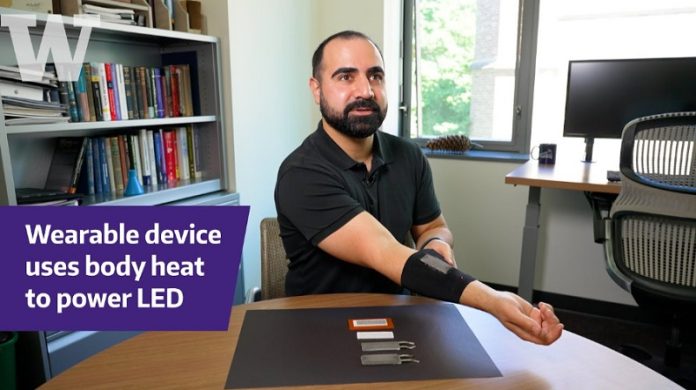
Researchers have created a stretchable, wearable device that can power small electronics, like an LED light, using just the heat from your body.
This breakthrough could lead to future wearables that never need charging by using body heat to generate electricity.
Wearable technology, such as fitness trackers, usually relies on batteries that eventually run out of power.
However, this new device can continuously generate electricity from body warmth, making it a potential game-changer for wearables.
The device is flexible and durable, designed to bend and stretch along with the body. It still works even after being pierced or stretched up to 2,000 times.
This makes it a resilient and reliable power source for small gadgets.
The team behind this innovation published their findings in Advanced Materials.
The senior researcher, Mohammad Malakooti, an assistant professor of mechanical engineering at the University of Washington, explained that the device lights up an LED as soon as it touches the skin, which wasn’t possible with previous technology.
In the past, devices that turned heat into electricity were often rigid and fragile, but Malakooti and his team developed a flexible, soft version that can easily conform to the wearer’s body. They designed the device from scratch, starting with computer simulations to determine the best materials and structure.
They then created nearly all the components in their lab.
The device has three main layers. At its core are solid thermoelectric semiconductors that convert heat into electricity. These are surrounded by specially designed 3D-printed materials that keep the device light and help it convert heat more efficiently.
To make it stretchy and able to heal itself if damaged, the semiconductors are connected with printed liquid metal traces. These liquid metal droplets also help transfer heat to the semiconductors while allowing the device to remain flexible.
While the initial focus is on wearables, this technology could have many other uses. For example, Malakooti suggests it could be applied to electronics that generate heat, like data centers. These devices could capture the excess heat from computers and servers and use it to power small sensors that monitor temperature and humidity. This would make the system more energy-efficient and sustainable.
Interestingly, the device can also work in reverse. By adding electricity, it could heat or cool surfaces, opening up possibilities for creating hot and cold sensations in virtual reality systems or making wearable devices more comfortable.
The research was supported by the National Science Foundation, Meta, and The Boeing Company, with additional contributions from researchers at the University of Washington and Izmir Institute of Technology.



